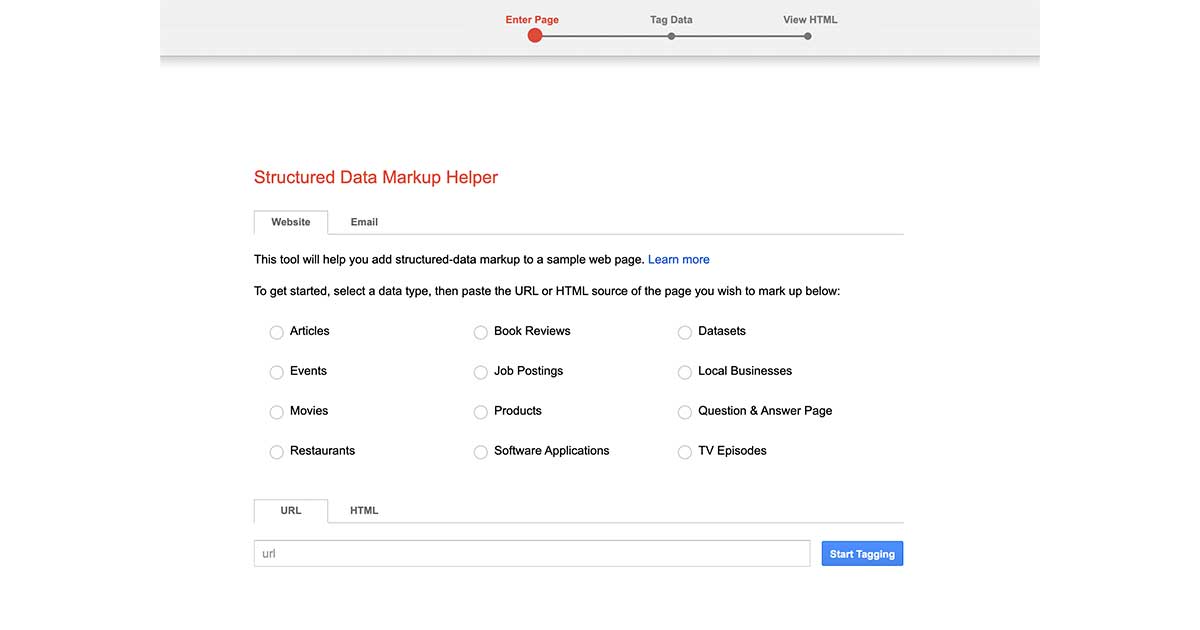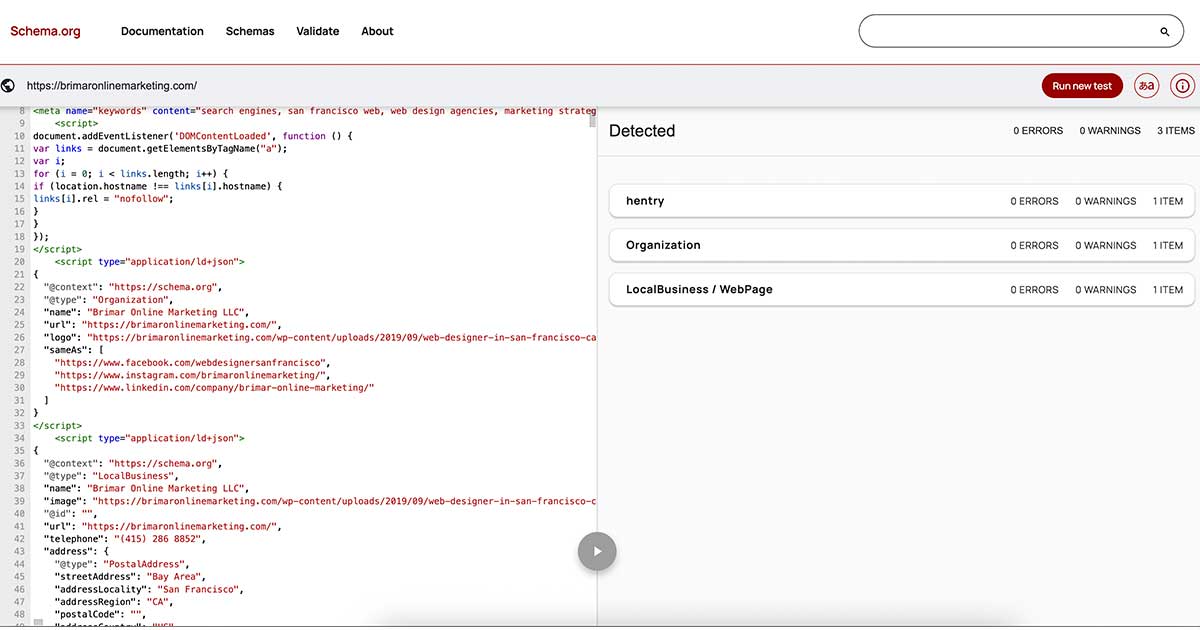
When someone types a question into Google and your page appears with additional details, such as star ratings, product prices, or event dates, that’s not luck.
That’s schema markup effectively working behind the scenes.
Schema markup is a small piece of code you add to your website’s content to help search engines understand it better.
It tells them what your page is about, whether you’re sharing a product, a recipe, a blog post, or even your business hours.
Think of it as giving Google a cheat sheet for your content.
And here’s why that matters: search engines don’t just want to list pages; they want to show results people are likelier to click.
Schema markup enhances your listing by converting it into a rich snippet.
That means more space, more information, and more eyes on your site.
When your listing includes a review schema with star ratings or product schema markup that shows prices and availability, it immediately stands out.
It earns trust.
It answers questions before someone even clicks.
That’s how schema leads to higher click-through rates, because users are drawn to listings that look like they’ve already done the hard work for them.
Search engines reward content that’s clear, structured, and helpful.
Schema markup gives them that structure.
It enhances your visibility, supports your SEO services initiatives, and elevates the presentation of your content in search results.
You’re not just showing up.
You’re showing up with details your audience cares about.
So when you see a competitor with star ratings or added info right in their search listing, know this: they’re using schema.
If you don’t, you’re giving them an advantage.
Let’s break this down even more.
What is Schema Markup and Why is it Important?
Schema markup originated as a collaborative effort among Google, Bing, Yahoo, and Yandex.
They created a common vocabulary, called schema.org, that websites can use to label specific types of content.
Whether it’s a local business listing, a product, a recipe, or a blog post, there’s a schema type that fits.
When you apply it correctly, search engines get a clearer picture of what’s on your page.
This isn’t about ranking higher by stuffing in keywords.
It’s about providing search engines with the context they need to display your content to the right audience.
That’s what improves user experience and gives your content a chance to appear as a rich result in search listings.
A basic snippet consists of a title, a URL, and a meta description.
But with schema markup, you can turn that into something more: show review scores, product prices, event details, or even FAQs.
That extra information grabs attention, builds credibility, and gets more people to click.
Start Attracting Customers Through SEO Today!
We can help you attract new customers through Tailored Search Engine Optimization Strategies for Your Business.
How Schema Markup Enhances CTR
Ever wonder why some listings in Google look more attractive than others?
Star ratings, event dates, author names, and pricing details, these aren’t random.
They’re made possible by structured data.
When someone sees five stars under your blog post or the exact price of your product before even clicking, it creates instant trust and relevance.
People want answers fast.
Schema markup delivers those answers right in the search engine results pages.
That’s where the magic happens.
The more relevant and detailed your snippet is, the higher the chance that people will click on it.
Let’s say you run a restaurant and use the local business schema.
You can display your business hours, phone number, and location directly in the search results.
That’s not just helpful, it’s the kind of information that turns searches into visits.
Or, if you’re selling products, using review schema and product schema markup can showcase your top reviews and pricing upfront.
That makes your listing more clickable and gives you a competitive edge over similar businesses who aren’t doing the same.
And the results speak for themselves.
Websites that use schema markup often experience a noticeable increase in click-through rates, sometimes by as much as 30%.
That’s not a small win.
That’s more visitors, more engagement, and more chances to turn clicks into customers.
Schema is one of the most overlooked but effective tools in SEO.
And the best part?
It’s available to everyone.
Most people don’t use it.
You’re not most people.
Most Common Types of Schema Markup
Schema solutions are not universally applicable.
Different types of content need different types of schema.
Here are some of the most useful ones, primarily if you’re focused on improving SEO and getting more out of your content:
- Article Schema
Perfect for blog posts and news articles. It provides search engines with key information, such as the author, publication date, and headline. It also helps surface your article in Google News and other discovery feeds. - FAQ Schema
If you’ve got a section with common questions and answers, this one’s gold. When applied correctly, Google can display the Q&A directly in search results, providing users with instant answers and encouraging them to click for more information. - Product Schema Markup
This is essential for e-commerce websites. It allows you to display product prices, availability, and ratings directly from the search listing. It’s one of the best ways to boost visibility and conversions. - Review Schema
Used to display star ratings and written reviews. This type of markup builds instant credibility. People are naturally drawn to social proof, which is why it is often featured prominently in search listings. - Event Schema Markup
If you’re hosting workshops, webinars, meetups, or any other type of event, this markup helps showcase the event’s date, location, and other details directly in search results. - Local Business Schema
Ideal for local businesses seeking to differentiate themselves in local search results. It highlights vital information, such as business hours, phone number, and address. It can also connect with Google Maps, enabling potential customers to find you more easily.
Each schema type adds relevant information to your listing, helping users find exactly what they’re looking for before they even click.
That’s where real value lives, making life easier for both search engines and real people.
Local SEO and Schema Markup
If you run a local business, this is where things get exciting.
Using the local business schema, you can tell Google everything it needs to know about your operation, your exact address, business hours, phone number, contact details, and more.
That makes it easier for your site to show up in local search results with rich snippets that matter.
Let’s say someone searches for “dentist near me” or “best coffee shop in San Francisco.”
With a local business schema in place, your business is more likely to appear with those extra details that catch attention, such as business hours, map location, customer reviews, and even appointment links.
That level of visibility can help you stand out from competitors.
And here’s the thing: most small businesses don’t bother with this.
They miss out on showing up in Google’s local pack or ranking higher in search results because their content lacks structure.
However, when you add schema, you’re not only improving your online presence; you’re also providing potential customers with additional information that helps them choose you over others.
It’s a simple move with long-term impact, and one of the best ways to improve your local SEO strategy.
Step-by-Step Guide to Implementing Schema
Adding schema markup to your site doesn’t require you to be a developer.
It’s actually simpler than it sounds.
Here’s a quick roadmap:
1. Pick the Right Schema Type

Start by identifying what kind of content you’re marking up.
Blog post?
Product page?
Event?
Match it with the proper schema type: article, review, FAQ, product, local business, etc.
This part is crucial for providing the relevant content and context that search engines require.
2. Use Google’s Structured Data Markup Helper
This tool walks you through the process.
You select your data type, paste in the URL or HTML, then highlight and tag parts of your content, like title, date, image, author, or product price.
It generates the code for you.
3. Add the Markup to Your Website
Once the helper gives you the code, you can paste it directly into your site’s HTML.
If you’re using WordPress, plugins like Rank Math or Yoast SEO make this even easier with built-in schema options.
4. Test Everything
Use Google’s Rich Results Test, the Structured Data Testing Tool, or the Schema Markup Validator to make sure your schema is set up correctly.
These tools will show you exactly what Google sees and flag any issues that need to be fixed.
5. Monitor Results in Google Search Console
After your structured data goes live, watch its performance closely.
Search Console provides insights into how often your rich snippets appear, what gets clicked, and where you can improve.
Don’t try to do everything at once.
Start small.
Add schema to your most valuable pages, your homepage, product pages, blog posts, or contact page.
The results can be surprising.
Sometimes, just showing star ratings or product prices is enough to push your page above the fold in search results.
And remember: schema markup isn’t just about feeding search engines; it’s about delivering extra information and essential details that make people stop scrolling and pay attention to your listing.
Best Practices for Adding Schema Markup

If you’re going to use schema markup, it’s worth doing it right.
Adding the wrong schema type or stuffing in extra details that don’t match the page can confuse search engines more than help them.
The goal here is clarity, not complexity.
First, ensure that the schema you’re using aligns with the content.
If it’s a blog post, use article schema.
If you’re answering questions, FAQ schema is the way to go.
Selling products?
You guessed it, product schema markup is your best friend.
It’s also smart to keep things honest.
Don’t fake reviews or add star ratings just to look good.
Google’s smarter than that; getting caught can hurt your SEO efforts in the long run.
A few best practices worth remembering:
- Use a schema markup generator or a plugin like Rank Math to simplify the process
- Stick to official types from schema.org so major search engines can recognize them
- Don’t overdo it, add relevant information, not every detail under the sun
- Always test your markup using Google’s Rich Results Test or the Schema Markup Validator
The key is balance.
You want to give just enough valuable information to make your listing stand out without overwhelming search engines or users.
The SEO Impact. Why Schema Markup is a Crucial Step
There’s no magic switch in SEO.
It’s the small steps, done consistently, that make the difference.
Schema markup is one of those steps that quietly boosts your online visibility without requiring additional ad spending or a complete website overhaul.
Think of it like this: Schema doesn’t replace good content, but it helps your website’s content speak more clearly to search engines.
That means more opportunities to appear in relevant search results, especially when users are searching for specific details that your page can answer.
If you’ve been investing time in your SEO strategy, but you’re not seeing the results you expected, structured data might be the missing piece.
It helps search engines understand your site more quickly and index the relevant pages for specific searches.
Want to see how it’s working?
Use Google Search Console to monitor impressions and CTRs after implementing schema.
Most websites that apply it correctly see a steady increase in clicks and page visibility.
And here’s a bonus: schema markup also supports voice search optimization.
When someone asks Google Assistant or Alexa a question, structured data helps your content be the one that gets read out loud.
That’s next-level visibility.
All from a few lines of code.
Schema Markup for Better User Experience

When someone’s searching for a product, a business, or an answer, they’re not looking for fluff.
They want key information quickly: the price, location, business hours, rating, or even a contact phone number.
When your site provides that extra information right on the search results page, it saves users time.
It also tells them that your business is legitimate, organized, and attentive to their needs.
This alone establishes trust even before they access your site.
Take local businesses, for example.
Using local business schema means your listing can include your address, opening hours, map location, and even directions.
That’s especially useful for people searching on their phones or in a rush.
Or think about e-commerce websites.
Displaying product prices, availability, and reviews enables potential customers to make informed decisions more quickly.
It’s the kind of user engagement that leads to more conversions and fewer bounces.
Ultimately, schema markup enhances the user experience by reducing the need for guesswork.
People don’t have to click multiple links to find the answers.
They receive relevant information upfront, which keeps them satisfied and encourages them to return.
Final Thoughts
If you’ve made it this far, you already understand that schema markup isn’t just some optional add-on.
It’s a smart move.
The kind that sets businesses apart in crowded search results.
Think about it: when someone searches for a service or product and your listing pops up with star ratings, product prices, business hours, or even event details, who do you think they’re more likely to click?
That’s the power of structured data.
You’re not merely attending; you’re presenting value, offering clarity, and providing all the additional information your audience seeks.
Incorporating schema provides your content with the depth and context that leading search engines require to understand your website genuinely.
It’s like giving Google a tour of your site with a flashlight and a map.
You’re handing them key information on a silver platter, whether that’s your phone number, FAQs, review scores, blog posts, or your business location.
It’s also one of the best ways to improve how your content performs in search rankings.
Schema helps your pages become more visible, clickable, and relevant to people searching for exactly what you offer.
Now here’s the thing: you don’t have to figure all this out on your own.
If you want help implementing schema markup the right way, without technical headaches or trial-and-error mistakes, we’ve got you.
At Brimar Online Marketing, we help local businesses, entrepreneurs, and online stores turn their websites into conversion machines.
From local business schema to product markup and everything in between, I can guide you through every step or do it for you.
Let’s give your site the boost it deserves.
Reach out today for a free SEO audit, and let’s see how we can unlock better visibility, more substantial rankings, and higher click-through rates for your business.
Our SEO Services Have Helped Our Clients Increase Their Revenue!
“I highly recommend Brimar if your looking to grow your online business. You will be satisfied with the high level of expertise and high quality of services. It has helped my business grow by leaps and bounds.”
CEO

